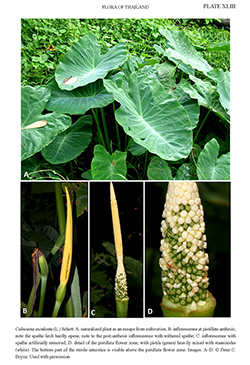e-Flora of Thailand
Volume 11 > Part 2 > Year 2012 > Page 214 > Araceae > Colocasia
1. Colocasia esculenta (L.) Schott
in Schott & Endl., Melet. Bot.: 18. 1832; Syn. Aroid.: 40. 1856 (sub. C. antiquorum) & Prodr. Syst. Aroid.: 138. 1860 (sub. C. antiquorum pr. Pte); Engl. in A.DC. & C.DC., Monogr. Phan. 2: 491–492. 1879 (sub. C. antiquorum pr. pte); Hook.f., Fl. Brit. India 6: 523. 1893 (sub. C. antiquorum pr. pte); Ridl., Mat. Fl. Malay Penins.: 16. (sub. C. antiquorum) 1907; Krause in Engl., Pflanzenr. IV, 23E (Heft 71): 65–68. 1920; Fl. Malay Penins. 5: 96. 1925 (sub. C. antiquorum); Gagnep. in Lecomte, Fl. Indo-Chine 6: 1139–1140. 1942 (sub. C. antiquorum pr. pte); Hu, Dansk Bot. Ark. 23: 428. 1968; Hay, Sandakania 7:33–36, Fig1. 1996; Li et al, Fl. China 23: 74. 2010.— Arum esculentum L., Sp. Pl.: 965. 1753.— Caladium esculentum (L.) Vent., Descr. Pl. Nov.: t. 30. 1801.— Colocasia antiquorum var. esculenta (L.) Schott, Syn. Aroid.: 41. 1856.— Leucocasia esculenta (L.) Nakai, Bull. Natl. Sci. Mus. Tokyo 31: 127. 1952. Plate XLIII.
Accepted Name : This is currently accepted.
Synonyms & Citations :
Description : Medium to large, occasionally very large, moderate to robust, solitary to colony-forming, evergreen herb to 1 m. Stem a tuberous or elongate rhizome, 3–5(–20) cm diam., if tuberous then vertical to horizontal and variably massive, larger tubers tending to be solitary while smaller tubers tending to clusters, plants with very reduced tubers frequently with long hypogeal non tuber-bearing stolons. Leaves several together; petiole 25–80 cm sheathing for ⅓ to ⅔ length, green, occasionally purple; leaf blade oblong-ovate to suborbicular, 13–45 by 10–35 cm, hydrophobic, dull glaucous green in most clones but cultivars with the leaves variously purple flushed through to deep purple black (remaining hydrophobic), base shallowly cordate, peltate, tissue in the sinus extending 1–7 cm, apex broadly and shortly cuspidate; primary lateral veins pinnate, forming submarginal collective vein; secondary and tertiary laterals arising from the primaries at a wide angle. Inflorescences 1–3 together; peduncle 16–26 cm; spathe 13–24 cm long, constricted between the lower part and the limb; lower part ellipsoid, 3.5–5 by 1.2–1.5 cm, green; spathe limb lanceolate or lanceolate-elliptic, 10–19 by 2–5 cm, acuminate, opening slightly at the base, the rest remaining furled during anthesis, cream to golden yellow; spadix shorter than the spathe; pistillate flower zone conical 3–3.5 by 1.2 cm; ovaries globose, ca 1–3 mm diam., green; stigma subsessile, narrower than apex of ovary, barely lobed; interpistillar staminodes clavate, white, mostly exceeding the ovaries; sterile interstice slender cylindrical, 3–3.3 cm; staminate flower zone cylindrical, 4–6.5 cm by 7 mm; synandria 2–3-merous, ca 0.8 mm diam., mid-yellow; appendix narrow conical, 1.5–4.5 cm, ca ⅕–⅛ entire spadix length. Fruiting peduncle declinate; fruiting spathe ellipsoid, breaking up irregularly; fruits ca 4 mm diam., ripening yellow-brown, strongly fruity-smelling.
Thailand : Throughout the Kingdom. Formal records include: NORTHERN: Chiang Mai, Lamphun; SOUTH-WESTERN: Phetchaburi; CENTRAL: Krung Thep Maha Nakhon (Bangkok); PENINSULAR: Chumphon, Phuket, Satun, Narathiwat.
Distribution : Natural wild distribution is much obscured by cultivation since prehistoric times as a carbohydrate and green vegetable crop. Widely cultivated in the tropics and sub- tropics and doubtfully native in much of its modern range. For a balanced discussion of the labyrinthine synonymy, see Hay, Sandakania, 7: 31–48. 1996.
Ecology : Roadside ditches, wet fields, as a crop and weed in cultivated and otherwise disturbed land.
Vernacular : Phueak (เผือก); bon khiao (บอนเขียว), bon chin dam (บอนจีนดำ)(Central); bon tha (บอนท่า), bon nam (บอนนำ)(Peninsular).
CommonName : Taro
Uses: Widely cultivated in the tropics and sub-tropics as a carbohydrate and green vegetable crop.
Notes: Confusion with larger forms of Colocasia fallax is possible although fertile plants of C. esculenta are readily separated by the much larger inflorescences with spathe limb bright yellow, opening slightly at the base but the rest remaining furled (vs small, purplish brown, and spreading fully), by the presence of interpistillar staminodes and by the proportionately much shorter spadix appendix (ca ⅕–⅛ vs ½–⅓ entire spadix length). Colocasia esculenta is only ever found in association with human disturbance.

